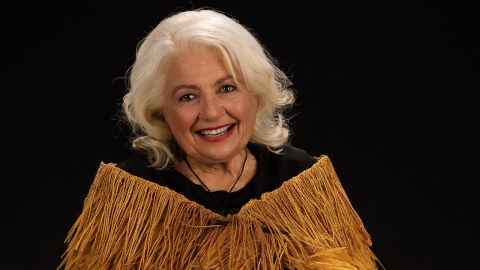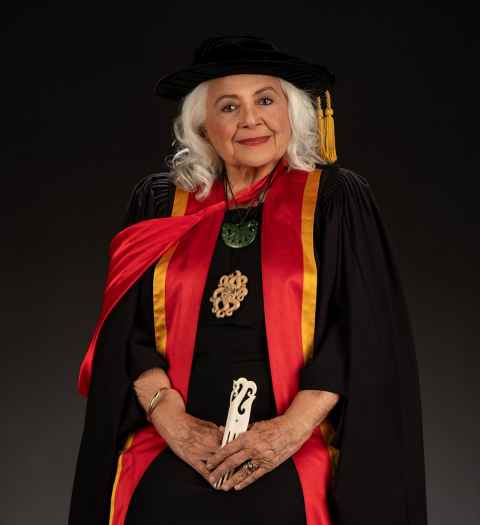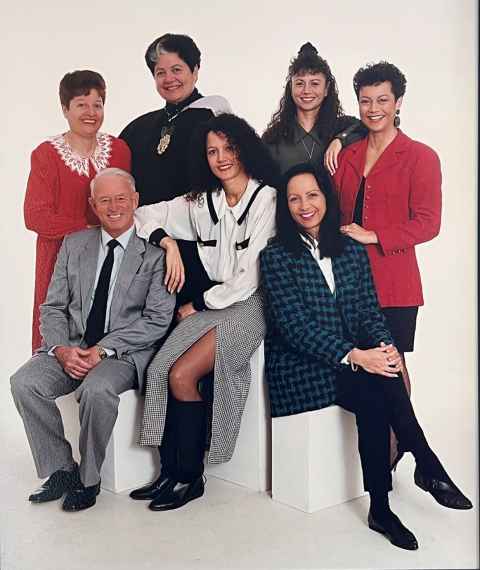Waiora Port at 90: living life like there's no tomorrow
1 September 2023
When Dr Waiora Port was growing up, there was no such thing as Māori Language Week. In fact, quite the opposite. She was even told to stop using her original Māori name.

Dr Waiora Port is an academic, mother and grandmother, but hides the pride in how her life has turned out. She says a “kūmara never speaks of its sweetness”.
Waiora (Te Aupouri, Te Rarawa) was born in Auckland but her whānau moved north to their tūrangawaewae, Manukau in Northland, when she was three months old.
“I was brought up with tikanga Māori because my mum was Māori. But I was also a graduate of the assimilation policy – I went to a ‘native school’ where we were not allowed to speak te reo Māori.
“At the time, this wasn’t such a problem for me because our dad was Pākehā. I just became a brown Pākehā.”
Waiora’s real first name is Ramari, but she became known as Waiora. She’s philosophical about it, in the way of people of her generation.
“R, especially at the beginning of the word, is the hardest letter for people to pronounce learning the Māori language.”
The headmaster said, “We can’t pronounce her first name. ‘Call her Viola, her second name.’ But because there is no V or L in Māori, my Māori grandmother thought she was pronouncing Viola correctly by calling me Waiora.”
Waiora stuck. “When I began learning te reo Māori in 1968, each learner chose a Māori name. I decided to stay known as Waiora in honour of the memory of my dearly loved grandmother calling me that.”
Waiora says the progress we’ve made with the acquisition and acceptance of learning te reo Māori in recent years is “amazing”.
“Sure sometimes there’s a backlash, but we all just need to keep going. In fact, whatever language belongs to you … you need to stay connected to it – Māori, Pacific languages, whatever.”
The headmaster said, “We can’t pronounce her first name. ‘Call her Viola, her second name.’ But because there is no V or L in Māori, my Māori grandmother thought she was pronouncing Viola correctly by calling me Waiora.” – Dr Waiora Port (Te Aupouri, Te Rarawa)

Waiora returned to Auckland when she was eight and was in her thirties when she learned te reo. Since then, it’s been part of her life and mana in her many roles, including her ongoing role on the Māori Advisory Board for the Centre for Brain Research (CBR) in the Faculty of Medical and Health Sciences. Which may not be so remarkable but for the path she took to get there.
Oh, and the fact she’s 90 years old.
Waiora began her first degree at the University of Auckland at 56, completing a BA double major in Education and Māori Studies in 1992, aged 60. She’d been teaching for years already, with the equivalent of a degree; a primary teaching certificate earned in 1953 and graded by inspectors during her classroom placement.
“I taught at Richmond Road School for 15 years. We were working seven days a week, making resources for a new bilingual school as well.”
She felt burnt out. “When you get crabby with children, you shouldn’t be there because it’s not fair. There must be joy in education.
“I decided to go to university and resigned at the end of 1987. A few days later, I was approached by one of the members of the school committee to become supervisor of Te Kōhanga Reo o Ritimana in Ponsonby, which I’d worked with the community and school to help establish and open in 1985.”
At first she joked that she didn’t want to be dealing with children under five, and that she would stick to her dream of going to university.
“I’d always been jealous of those who had gone. But then I took time to consider. I believed in te reo and always wished my children had had the opportunity to attend a kōhanga. I eventually offered to do three days a week there for a year, while also enrolling in six papers at uni.
“I surprised myself by doing well. It was hard work but I managed, with help from wonderful staff, to stay in that position for four years and so complete my undergraduate degree.”
After Waiora graduated with a Bachelor of Arts, her skills were sought by a different faculty.
“Geneticist Cyril Chapman from the Medical School wanted someone who could speak Māori to help him with his research on club foot, to speak to Māori families.”
She felt an obligation to help as there was club foot (talipes equinovarus) in her own whānau.
“It’s six times more likely in Māori than Pākehā.”
Up until she began working on Chapman’s research, she hadn’t had to use a computer but tackled that like she has everything in life.
“I thought learning how to use one could be an asset to me.”
Waiora took the 18-month contract and initially thought she’d put her MA on hold, until Graham Hingangaroa Smith (Ngāti Porou, Ngāi Tahu, Ngāti Apa and Ngāti Kahungunu) and Linda Tuhiwai Smith (Ngāti Awa, Ngāti Porou), both now professors, encouraged her to continue. She was able to enrol late and the late fee was paid.
“Graham and Linda were the best education lecturers … we did things in a Māori way together, helping each other.”
The result was a MA thesis, incorporating skills learned in her BA alongside Chapman’s genetic research, called ‘He mate huhua, he tirohanga Māori: Clubfoot, Māori attitudes to disability’.
You need social scientists to be able to talk to people, the patients especially, or you can’t make progress. It’s how we work together that counts.

Initially I lived my life like I was going to die aged 60, because none of my aunties or uncles on my mother’s side lived to that age. Around five cousins died when they were about 57. That’s why I wouldn’t let my children give me a 60th birthday party.
Following the MA came a PhD and by now her focus was health research. “But I’m a social scientist so medical science was all new for me.
“What I’d say about that is you need social scientists to be able to talk to the people, the patients especially, or you can’t make progress.
“It’s how we work together that counts, and culture is important in people’s recovery. If your mind is upset or you don’t understand, it’s not going to be a good outcome.”
Her doctorate was a steep learning curve, but one she embraced.
“It was much harder because I’d crossed over from education to health so I couldn’t go back on all my readings from education; I couldn’t draw on what I’d learned before.”
It was also tough personally because she began her doctoral research not long after she and husband Garth tragically lost one of their five daughters to bowel cancer, aged just 43.
Having something else to focus on kept her busy and learning at a very difficult time.
“I learnt a certain amount about genetics, but mainly my role was to negotiate between clinicians and families; to be their speaker if they were too shy or just reluctant.”
In 2007, aged 74, she graduated with a PhD in Māori and Pacific Health and Molecular Medicine with her thesis: “He whakamātautau pi taua mo te mate pukupuku: ngā tikanga a te ao Māori/DNA testing for cancer susceptibility: the needs of Māori”.
“I couldn’t have done all this without a spiritual belief and a deep feeling of being helped.”
Over the years, she herself has helped many people, not just her whānau which includes 11 grandchildren and six great-grandchildren. In August she was helping again, with preparations for a granddaughter’s wedding.
She even helped out at the University on a significant birthday, after she was asked by Professor Sir Richard Faull, director of the Centre for Brain Research (CBR), to give a mihi and kōrero at the inaugural lecture of Professor Chris Shaw, who joined the CBR in 2022. It was the day she turned 90, 17 October. Fittingly, she received a big bunch of flowers at the end.
Sir Richard describes Waiora as “our taonga”. He had first met her in the 1980s when she was a research assistant.
“Right from the beginning, and later with the establishment of the CBR, Waiora has been our ‘rock’ for our outreach and engagement with Māori. She has advised, guided and mentored us on all things Māori.
“As our kuia, Waiora always accompanies us on our CBR hui and visits to marae and whānau and ensures we follow tikanga for all engagement with whānau, hapū and iwi.
“She mentors our research group leaders and graduate students in our Māori outreach and engagement. She has also been pivotal for me personally, as a guiding light in my personal outreach and engagement with my whakapapa, Te Āti Awa, Ngāti Rāhiri.”
Waiora also had obvious experience of longevity she could draw on while working with researchers on the LiLACS study, a long-running study of New Zealanders living into advanced age.
In her 91st year, Waiora is still making jam, baking pikelets and scones for guests, and trying new things. Outside her family home of many decades, under a big shady tree, is a chair in which she sits from time to time.
“I’ve been doing ‘earthing,’” she laughs. “Sitting with my bare feet on the ground. I’ve heard it’s good for your health. I’m sure I feel better!
“Initially I lived my life like I was going to die aged 60, because none of my aunties or uncles on my mother’s side lived to that age. Around five cousins died when they were about 57. That’s why I wouldn’t let my children give me a 60th birthday party.”
Garth, Waiora’s husband of more than 60 years, died in 2014 and is buried in an urupā at Manukau. Although he was Pākehā, kaumātua agreed he could be buried there.
“He’s in the basement and when I join him, I will be in the penthouse,” she laughs.
Not any time soon, I say.
“Oh no, I’m all good. But when I do go, I don’t mind. I’m ready.”
Te Wiki o Te Reo Māori runs 11-18 September 2023.
This article first appeared in the September 2023 edition of UniNews.